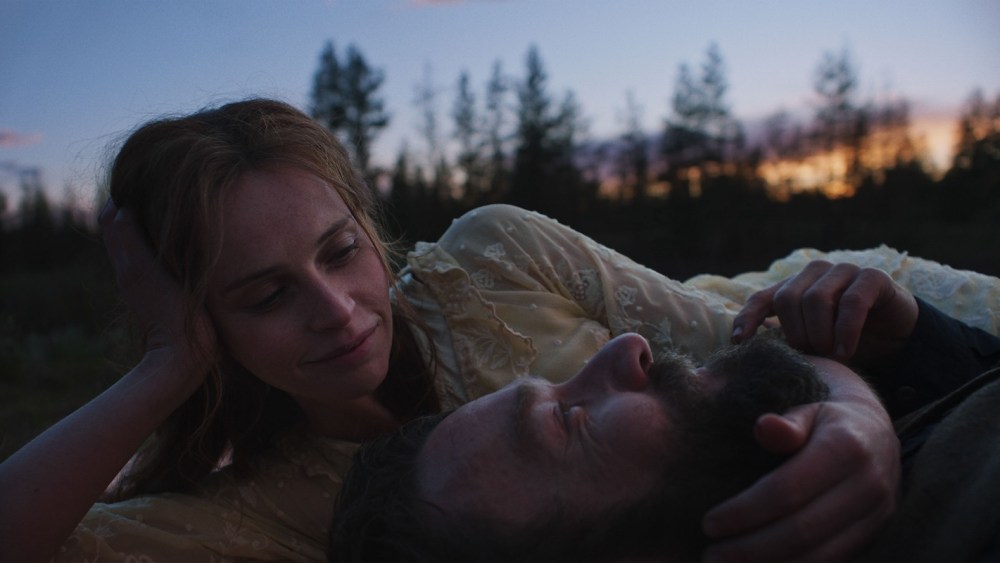A Landmark Homage to America’s Unsung Workers
With a handsome actor like Joel Edgerton, audiences typically find themselves looking at his face, or those ice-blue movie-star eyes. But in “Train Dreams,” I found myself looking at his hands, great big mitts, with thick fingers and knuckles like gnarled roots that don’t get that way on their own. Over the years, I’ve seen more movies than I can count in which pampered actors who’ve never lifted an ax or changed a tire in their lives try to convince us they’ve spent decades in the coal mines. Edgerton feels like the real deal.
In “Train Dreams,” the Australian actor channels the spirit of the men who tamed the American Cascades, chopping down trees and laying track. Somewhere between an elegy and an anthem, this gorgeous, almost-century-spanning film was directed by Clint Bentley, one half of the creative team responsible for “Sing Sing” and “Jockey” (he co-wrote it with Greg Kwedar, with whom he takes turns directing). The inspiration hails from a slender, evocative novella by Denis Johnson that honors the manual laborers who built this country, focusing on one in particular, Robert Grainier, who carved out a window of happiness for a time.
What must their lives have been like, these nameless laborers? Who did they love? How did they die? What questions did they ask, as they stared up at the night sky, contemplating the stars or a doomsday comet? It will not surprise you that any film that puts its head to such notions owes a debt to Terrence Malick, the filmmaker who gave the medium a ruminative freedom with which to wax philosophical, even spiritual. He too considered the lives of itinerant workers, circa 1916, and now, with “Train Dreams,” Bentley does for the Pacific Northwest what “Days of Heaven” did for the Texas Panhandle — except, in this case, he spans several decades.
Many of the men alongside whom Grainier works get by without knowing a woman’s love, but in this arena, Grainier is fortunate. He meets and marries Gladys (a luminous Felicity Jones), and the couple make a home for themselves along an uncultivated stream, where she raises their daughter while Dad’s away cutting timber. Channeling “The New World” cinematographer Emmanuel Lubezki, DP Adolpho Veloso shoots these scenes at magic hour, selecting moments of simple domestic satisfaction to represent Grainier’s time between backbreaking gigs — idyllic souvenirs that return to him in flashes when he’s away on the job, or years later, looking back.
Just because Malick’s influence can be felt does not mean that Bentley hasn’t found his own vocabulary to tell Grainier’s story. At times, “Train Dreams” feels almost quilt-like in the way its pieces fit together, with certain sounds and images flickering briefly, almost subliminally, across our consciousness, only to be repeated later. The film’s overarching design follows meaningful encounters, many of them with people Grainier meets just once or twice, but whose words shape his understanding of the world. “Ain’t there any place in this world a man can get some peace?” growls one loner, anticipating the self-isolating Jeremiah Johnson-like mentality that awaits Grainier. Though Bentley casts a few familiar character actors in bit parts, so many of these faces appear as rugged and authentic-looking as Edgerton’s own.
One can’t help noticing a sense of the still-lawless frontier, where life can be taken swiftly and without warning. Grainier learns that early, stumbling across a dying man (“Jockey” star Clifford Collins Jr.) cut behind the knees and left for dead by the man who robbed him. Danger comes with the territory: A tree falls in the wrong direction and crushes three men, or white folks decide they don’t like the “Chinaman” working alongside them and toss him off a bridge. Something about that last scenario sticks with Grainier, who went along with the crowd and held the man’s legs. The memory haunts his dreams, and he comes to believe that he’s cursed.
What else could explain the horrific turn the film takes when a wildfire breaks out? Bentley couldn’t have known the devastation that would strike Southern California just weeks before his film premiered at the Sundance Film Festival this year, and yet, these natural disasters are as much a part of American life as the human impulse to expand. “Train Dreams” depicts that give-and-take dynamic, celebrating those who tamed the West — men whose anonymous, sunburned mugs appeared in antique photos, no bigger than Lincoln’s head on the face of a penny, staring out from the base of century-old tree trunks.
“It’s not the great pyramids of Egypt,” says the foreman, but clearing forests and connecting cities by rail is a feat that took countless men — the modern equivalent of constructing the Roman aqueducts or the Great Wall of China. Edgerton embodies just one of those workers, though we’re not meant to assume they were all like his. Drawing carefully from Johnson’s text, the script treats Grainier as an individual, distinguishing him from the other characters he encounters — men like Apostle Frank (Paul Schneider) and Arn Peeples (William H. Macy), who meet their maker before his eyes.
Legacy doesn’t much seem to matter to these men. At the burial site of several workplace casualties, Arn hammers the fallen co-workers’ boots to a tree — an image foreshadowed earlier, once the trunks have had time to grow around the leather. As with Malick’s films, one gets the sense that “Train Dreams” could’ve taken any number of forms. Surely Bentley and editor Parker Laramie experimented with several, trying to find the right balance between abstract poetry and narrative storytelling, without leaning too heavily on aspects that will bring some to tears.
They’re aided throughout by Bryce Dessner’s string score and eloquent, salt-of-the-earth narration from Will Patton (who also recorded the audiobook, repeating choice lines of Johnson’s at key moments here). Some purists see voice-over as a crutch, but this feels like an excellent example of that technique done right, adding depth that Edgerton’s largely wordless performance and the breathtaking cinematography could not achieve without it. Conversely, by putting a face (and those enormous hands) to the character, plus footage of the places Grainier lived and worked, Bentley’s film accomplishes something the book could not: It brings a visual dimension to this modest monument, creating a record that history somehow missed.


